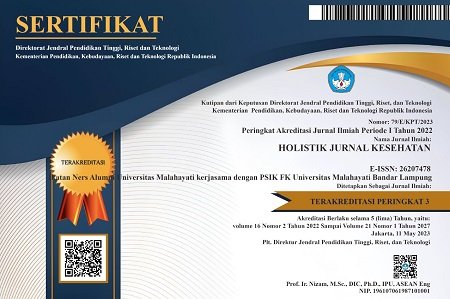Effect of an electronic medication administration record application on patient safety: A literature review
Abstract
Background: Electronic medication administration records (e-MAR) is a one of information technology utilized by nurses. The transition from paper-based to electronic methods requires consideration of the benefits and risks.
Purpose: Identifies the effect of implementing e-MAR on patient safety.
Method: Literature study on articles published in 2013-2023, in English, and published in full.
Results: 5 articles retrieved from a systematic search on the Proquest and ScienceDirect databases, 1 article was obtained through hand searching, total 6 articles were reviewed in the study.
Conclusion: The implementation of electronic medication administration records (e-MAR) has been proven to reduce the risk of medication process errors carried out by nurses thereby increasing patient safety while undergoing treatment at health service facilities.
Keywords: Electronic Medication Administration Records; Medication Error; Nurse; Patient Safety.
Pendahuluan: Pendokumentasian proses medikasi berbasis elektronik atau (electronic medication administration records (e-MAR) merupakan bentuk pemanfaatan teknologi informasi oleh perawat. Transisi dari metode berbasis kertas ke elektronik perlu dipertimbangkan manfaat dan risikonya.
Tujuan: Mengidentifikasi pengaruh implementasi e-MAR terhadap keselamatan pasien.
Metode: Menggunakan metode literature review. Penelusuran artikel akademik melalui Online Database diantaranya ProQuest dan ScienceDirect. Dan didapatkan 6 artikel yang sesuai.studi literatur pada artikel yang terpublikasi pada 2013- 2023, berbahasa Inggris, dan terpublikasi lengkap.
Hasil: 5 artikel hasil penelusuran sistematis pada database ProQuest dan ScienceDirect , 1 artikel diperoleh melalui hand searching sehingga teridentifikasi 6 artikel yang ditelaah dalam studi ini.
Simpulan: Implementasi electronic medication administration record (e-MAR) terbukti dapat menurunkan risiko kesalahan proses medikasi yang dilakukan oleh perawat sehingga meningkatkan keselamatan pasien selama menjalani perawatan di fasilitas pelayanan kesehatan.
Keywords
References
Altavilla, S., Thornton, J. M., & Almodovar, M. C. (2011). Assessing the introduction of enterprise-wide clinical information systems in pediatric medical center. Progress in Pediatric Cardiology, 32(2), 141-145.
Assiri, G. (2022). The Impact of patient access to their electronic health record on medication management safety: A narrative review. Saudi Pharmaceutical Journal, 30(3), 185-194.
Awad, S., Amon, K., Baillie, A., Loveday, T., & Baysari, M. T. (2023). Human factors and safety analysis methods used in the design and redesign of electronic medication management systems: A systematic review. International Journal of Medical Informatics, 105017..
Capan, M., Wu, P., Campbell, M., Mascioli, S., & Jackson, E. V. (2017). Using electronic health records and nursing assessment to redesign clinical early recognition systems. Health Systems, 6(2), 112-121.
Carayon, P., & Hoonakker, P. (2019). Human factors and usability for health information technology: old and new challenges. Yearbook of medical informatics, 28(01), 071-077.
Dabliz, R., Poon, S. K., Fairbrother, G., Ritchie, A., Soo, G., Burke, R., & Penm, J. (2021). Medication safety improvements during care transitions in an Australian intensive care unit following implementation of an electronic medication management system. International Journal of Medical Informatics, 145, 104325.
Dallat, C., Salmon, P. M., & Goode, N. (2018). Identifying risks and emergent risks across sociotechnical systems: the NETworked hazard analysis and risk management system (NET-HARMS). Theoretical issues in ergonomics science, 19(4), 456-482.
de Jong, C. C., Ros, W. J., van Leeuwen, M., & Schrijvers, G. (2016). Exploring the effects of patients taking a vigilant role in collaborating on their e-medication administration record. International Journal of Medical Informatics, 88, 18-24.
Dickerson, A. (2023). Nurses’ Experiences Transitioning from Paper to Electronic Health Records: A Pilot Study (Doctoral dissertation, University of Mount Olive).
Jheeta, S., & Franklin, B. D. (2017). The impact of a hospital electronic prescribing and medication administration system on medication administration safety: an observational study. BMC health services research, 17, 1-10.
Kruse, C. S., Mileski, M., Syal, R., MacNeil, L., Chabarria, E., & Basch, C. (2021). Evaluating the relationship between health information technology and safer-prescribing in the long-term care setting: a systematic review. Technology and Health Care, 29(1), 1-14.
Kushniruk, A., Nohr, C., & Borycki, E. (2016). Human factors for more usable and safer health information technology: where are we now and where do we go from here?. Yearbook of medical informatics, 25(01), 120-125..
Leung, M., Chan, K. K. C., Wong, W. L., & Law, A. C. B. (2018). Impact of IPMOE on nursing tasks in the medical ward: a time-motion study. International journal of nursing sciences, 5(1), 50-56.
Lin, J. C., Lee, T. T., & Mills, M. E. (2018). Evaluation of a barcode medication administration information system. CIN: Computers, Informatics, Nursing, 36(12), 596-602.
Prgomet, M., Li, L., Niazkhani, Z., Georgiou, A., & Westbrook, J. I. (2017). Impact of commercial computerized provider order entry (CPOE) and clinical decision support systems (CDSSs) on medication errors, length of stay, and mortality in intensive care units: a systematic review and meta-analysis. Journal of the American Medical Informatics Association, 24(2), 413-422.
Qian, S., Yu, P., & Hailey, D. M. (2015). The impact of electronic medication administration records in a residential aged care home. International Journal of Medical Informatics, 84(11), 966-973.
Risør, B. W., Lisby, M., & Sørensen, J. (2017). Cost-effectiveness analysis of an automated medication system implemented in a Danish hospital setting. Value in Health, 20(7), 886-893.
Seibert, H. H., Maddox, R. R., Flynn, E. A., & Williams, C. K. (2014). Effect of barcode technology with electronic medication administration record on medication accuracy rates. American Journal of Health-System Pharmacy, 71(3), 209-218.
Stolic, S., Ng, L., & Sheridan, G. (2023). Electronic medication administration records and nursing administration of medications: An integrative review. Collegian, 30(1), 163-189.
Westbrook, J. I., Sunderland, N. S., Woods, A., Raban, M. Z., Gates, P., & Li, L. (2020). Changes in medication administration error rates associated with the introduction of electronic medication systems in hospitals: a multisite controlled before and after study. BMJ Health & Care Informatics, 27(3).
Zaman, N., Goldberg, D. M., Kelly, S., Russell, R. S., & Drye, S. L. (2021). The relationship between nurses’ training and perceptions of electronic documentation systems. Nursing Reports, 11(1), 12-27..
Zheng, W. Y., Lichtner, V., Van Dort, B. A., & Baysari, M. T. (2021). The impact of introducing automated dispensing cabinets, barcode medication administration, and closed-loop electronic medication management systems on work processes and safety of controlled medications in hospitals: A systematic review. Research in Social and Administrative Pharmacy, 17(5), 832-841.
DOI: https://doi.org/10.33024/hjk.v17i8.13031
Refbacks
- There are currently no refbacks.
Copyright (c) 2023 Holistik Jurnal Kesehatan

This work is licensed under a Creative Commons Attribution-NonCommercial 4.0 International License.














